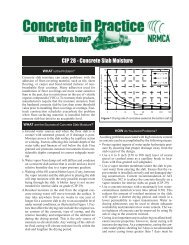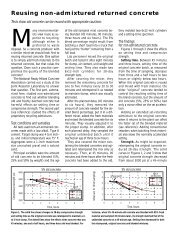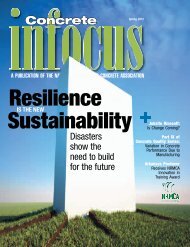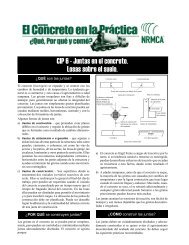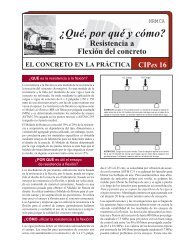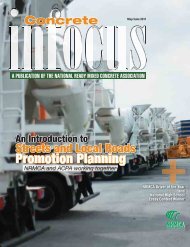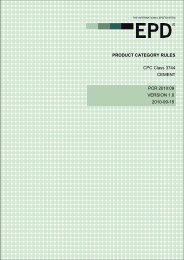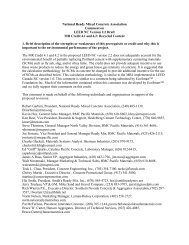2010 NRMCA - National Ready Mixed Concrete Association
2010 NRMCA - National Ready Mixed Concrete Association
2010 NRMCA - National Ready Mixed Concrete Association
You also want an ePaper? Increase the reach of your titles
YUMPU automatically turns print PDFs into web optimized ePapers that Google loves.
truck tracsTake Control of Your 2011 Fuel BudgetFuel price protectionoffers a new, uniqueapproach to fuel budgetcontrol.With the downturn in the economy,the ready mixed concrete industry isbeing forced to price bids competitivelywith little room for error—any inaccuracyin your cost estimates can hurt your cash flowand earnings. And while many are diligent incapturing the cost of materials and labor in theirbids, most struggle with estimating fuel costs.As a major cost, fuel poses aunique challenge to the ready mixedconcrete industryWhile many fleets track their fuel usage inmiles per gallon, this does not provide a truepicture of fuel usage for ready mixed concretecompanies like yours. Mixer trucks spend varyingamounts of time at idle, mixing concrete oroff-road travel. And this is before we even considerpower-take-off (PTO) energy use. A 2006<strong>NRMCA</strong> study found that PTO accounts for20-25% of total fuel consumption alone.<strong>Ready</strong> mixed concrete companies, along withother businesses, have found it extremely difficultto accurately pin down fuel costs. Since 1999,the average annual price movement from lowto high as reported by the U.S. Dept. of Energy(DOE) is $0.7544/gallon. Even if we disregard2008, which presented unprecedented fuel pricefluctuations, the yearly average fluctuation isapproximately $0.61 since 1999. As many know,even small fuel price increases can result in large,unbudgeted fuel cost variance.These dramatic price fluctuations coupledwith a longer construction season (from whatused to be a nine month season to now 12months) makes it even more difficult for you toforecast future fuel prices to accurately price abid upfront.With growing emerging market demand,weakened U.S. dollar, geopolitical realities of theMiddle East combined with unexpected naturaldisasters, fuel prices are anyone’s best guessand continue to expose companies to significantoperating risk. As a result, it’s crucial for yourcompany to adopt a more strategic and proactiveapproach to protecting your fuel budgets.Introducing fuel price protectionHistorically, most companies were not ableto hedge their fuel costs because they did nothave large enough fuel budgets or the necessaryin-house expertise to decipher and navigate thefuel commodities market. This is changing withadvances in technology and fi nancial instrumentsgiving companies of all sizes more control overtheir fuel budgets.Fuel price protection offers a new, uniqueapproach to fuel budget control. You select aprotection price that represents the most yourcompany wants to pay for fuel. When fuel prices(as measured by an index such as the U.S. DOEnational average fuel price) go above that protectionprice, your company receives a payment equalto the difference. This allows you to accuratelypredict your company’s maximum fuel costs.With this fi nancial arrangement, there is nochange to how you fuel your fleet and no pre-purchaseof fuel. Fuel is still purchased at the pump,in bulk, or via a discount fuel card. Fuel price protectionis not tied to actual usage. If the predictedamount of fuel is not used, there is no cost to yourcompany. And if fuel prices drop, you can stillbuy fuel at the current, lower market price.Fuel price protection offers some specificadvantages to the ready mixed concrete industry:° Increases competitive advantage: Remainprofitable by locking in your project marginsupfront without worrying about cost overrunsdue to fuel. Ultimately, this may enable youto undercut the competition with fi xed bids/contracts and gain market share.° Helps mitigate risk: Better upfront risk planningcan help you cap your fi nancial exposure,prevent detrimental damage to your fuel budgetand protect your bottom line.° It’s proactive: Protect your most volatileexpense upfront and redirect your limitedresources to focus on strategic initiatives.Why are we discussing fuel priceprotection now?Since 1999, the lowest fuel prices have occurredon average within a six week timeframe—betweenCONCRETE in focus ı 9



